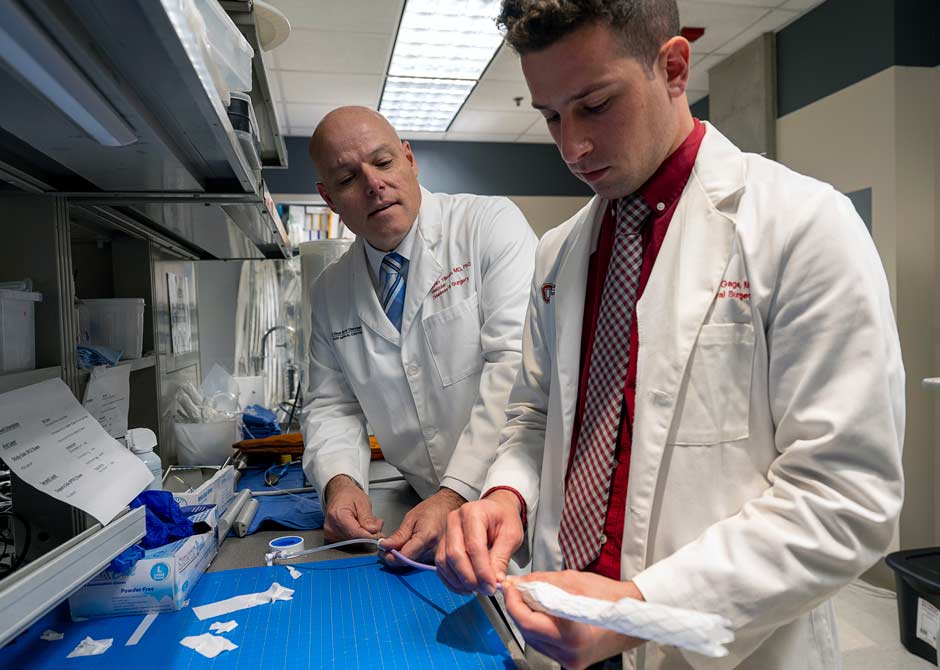 One evening in 2015, vascular surgeon Bryan Tillman, MD, PhD, was sitting in his family room with his neighbor. They were both inspired to make a difference after witnessing challenges his son and another child in his neighborhood – who were both battling cancer – had during their treatments. On a simple paper napkin, the two started sketching out an idea for retrievable stent-graft technology that could make all the difference for Dr. Tillman’s son and his neighbor friend. And little did Dr. Tillman know then that the sketched idea would have the potential to take on many different applications and help a much broader patient population.
One evening in 2015, vascular surgeon Bryan Tillman, MD, PhD, was sitting in his family room with his neighbor. They were both inspired to make a difference after witnessing challenges his son and another child in his neighborhood – who were both battling cancer – had during their treatments. On a simple paper napkin, the two started sketching out an idea for retrievable stent-graft technology that could make all the difference for Dr. Tillman’s son and his neighbor friend. And little did Dr. Tillman know then that the sketched idea would have the potential to take on many different applications and help a much broader patient population.
Taking that napkin back to his lab, Dr. Tillman developed a dumbbell-shaped stent that’s removed after use – leaving nothing behind – and while inserted, serves as a vehicle to deliver drugs to the blood vessel wall while at the same time preserving blood flow to tissue that’s past the stent.
Dr. Tillman has always had a passion for vascular research. He says the sheer number of critical care needs of his patients inspires him every day to find new and better ways to treat them. As he developed his new drug delivery stent, he found numerous potential applications for vascular patients, including the delivery of drugs to prevent the rupture of aneurysms and to avoid the failure of other vascular procedures due to restenosis.
Restenosis is the formation of scar tissue after most vascular interventions that results in a blockage of a blood vessel. Restenosis is the reason that almost half of all vascular procedures fail in less than five years. Dr. Tillman says after witnessing how this problem threatens up to half of his patients, he wanted to investigate ways to prevent it. He hypothesizes that his novel stent will prevent restenosis more effectively than current approaches.
The National Heart, Lung, and Blood Institute (NHLBI) of the National Institutes of Health (NIH) also recognizes the potential this stent has in helping the lives of patients, particularly those experiencing restenosis. In June 2024, the NHLBI awarded Dr. Tillman, who is the associate professor of Surgery in the Ohio State University College of Medicine, with with his second R01 grant – a four-year, $2.7 million grant to study the use of a novel stent to prevent restenosis.
A Look at Dr. Tillman’s Hypothesis
Currently, a drug-coated balloon is used to block scar tissue and prevent restenosis. This approach carries three major limitations. These include the limited amount of drug that sticks to the balloon, drug washing off the balloon and not reaching its target, and the balloon only being able to be used briefly because it restricts blood flow.
He and his co-investigator, Saami Yazdani, PhD, an associate professor of Engineering at Wake Forest University, theorize the novel stent will remain in place for drug delivery longer than a balloon, prevent loss of the drug reaching the entire circulation, and infuse any type of liquid drug that’s currently not possible with a balloon approach.
The grant will allow Dr. Tillman and Dr. Yazdani to further study the novel stent and how effectively it will prevent restenosis. And ultimately, the study may offer a more effective therapy for restenosis and, more broadly, new approaches for focused drug delivery in treating a variety of other conditions.
The Future of the Novel Stent
Dr. Tillman’s work doesn’t end with preventing restenosis. He says many vascular conditions threaten either life or limb, and innovation offers us the potential to deliver some truly life-changing opportunities.
“What I love most about vascular surgery is that it truly is the conduit to all other parts of the body, which offers lots of exciting horizons,” Dr. Tillman says. “It seems that before we are even done with one innovation, a new one pops up.”
In July 2024, Dr. Tillman was awarded a Transformational Award from the American Heart Association to explore the drug infusion stent graft to prevent growth of potentially life-threatening aneurysms in the aorta, the largest blood vessel of the body.
And Dr. Tillman’s novel drug delivery stent technology has already been used in his lab to control traumatic hemorrhage, and to perfuse donor organs for transplant and to deliver drugs to blood vessel walls. The team is now working on a new stent technology to make the Division of Vascular Surgery’s biggest open vascular surgery safer for patients.
Additionally, Dr. Tillman and his team developed an important spinoff to create a gateway in the previously impassable blood-brain barrier that surrounds the brain and spinal cord. The latter offers fascinating opportunities to intervene well outside the vascular system, including drugs to potentially treat spinal cord injury, neurodegenerative disorders and cancers of the brain and spinal cord.
What started on a simple paper napkin is truly making a difference for patients and has the potential to save countless lives.
